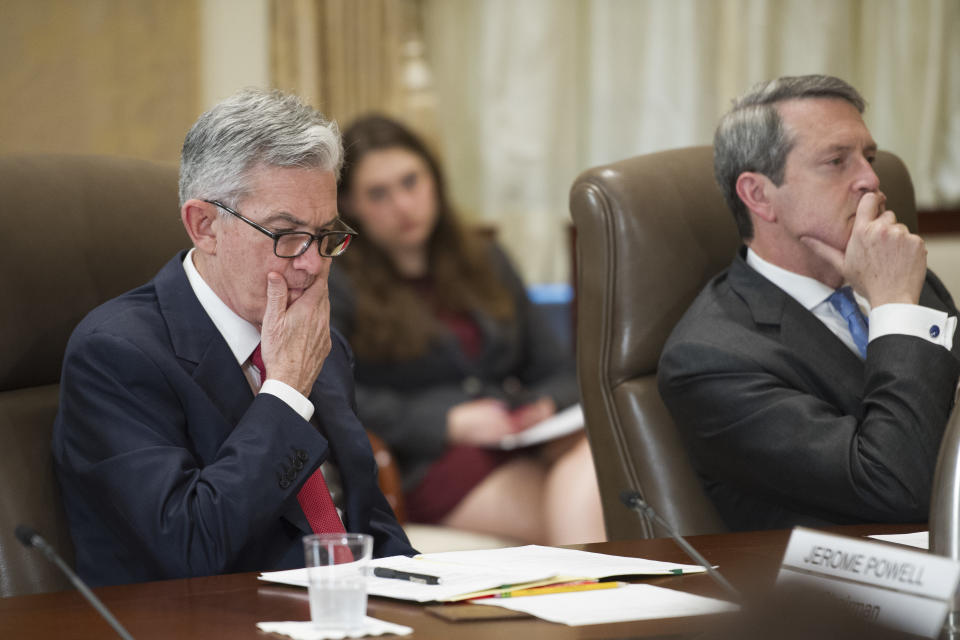Fed to cap bank dividend payments after completing stress test, COVID analysis
The Federal Reserve will bar big banks from increasing their dividend payments, following the central bank’s annual stress tests that included a “sensitivity” analysis incorporating the impact of the COVID-19 crisis.
The Fed on Thursday afternoon described 33 of the nation’s largest banks as a “source of strength,” noting that all the banks appear strongly capitalized to deal with a harsh economic downturn.
But the central bank said it would impose dividend caps and a restriction on share buybacks in the third quarter of this year to “ensure large banks remain resilient despite the economic uncertainty from the coronavirus event.”
Dividends will be capped at either the amount paid in the previous quarter or the quarterly average of income made over the last four quarters, whichever is less. On buybacks, the nation’s eight largest banks had previously committed to suspending share buybacks for the first and second quarters.
Senior Fed officials said the Fed may consider additional stress tests and could extend the dividend and buyback restrictions depending on how the economy evolves.
The Fed will also require the banks to resubmit and update their plans on capital distributions later this year.
Fed Governor Lael Brainard was the lone member of the Fed who dissented against the restrictions, arguing that allowing banks to pay dividends at all “raises the risk they will need to tighten credit or rebuild capital during the recovery.”
Fed Vice Chairman of Supervision Randal Quarles, the architect of the supervisory regime, insisted that the central bank could “take additional policy actions” if needed.

V, U, or W?
The stress tests, a key supervisory exercise beefed up after the 08-09 crisis, apply a theoretical “adverse scenario” to bank balance sheets to determine if the nation’s largest firms have enough capital to survive a harsh economic downturn.
The scenario, however, was announced before the COVID-19 crisis and modeled an unemployment rate spiking to 10% with real GDP falling about 8.5% from its pre-recession peak. Those figures pale in comparison to the 13.3% unemployment rate and likely double-digit GDP contractions inflicted on the U.S. economy by the coronavirus-induced shutdowns.
The Fed added a “sensitivity” analysis to its stress tests in which the central bank modeled the impact of a V-shaped, U-shaped, or W-shaped recovery with varying peak unemployment rates and peak-to-trough GDP changes.
The central bank did not disclose firm-specific details on the scenario runs, but said “several” financial institutions would reach minimum capital requirements set by the Fed under U and W-shaped recoveries.
The Fed reported that aggregate capital ratios for the industry would fall from 12% in the fourth quarter of 2019 to between 9.5% and 7.7% under the varying scenarios.
“The results of our sensitivity analyses show that our banks can remain strong in the face of even the harshest shocks,” Quarles said in a statement.
The last-minute sensitivity analysis did not include planned capital distributions, which the Fed said would have resulted in a reduction in aggregate capital ratios of about 50 basis points.
The Fed’s regular stress test, however, did disclose firm-by-firm results and noted that none of the 33 financial institutions tested failed to fall below regulatory minimums set by supervisors.
Under a new regulatory regime, the Fed will incorporate this year’s stress tests results into new regulatory minimums using a “stress capital buffer.” Those buffers, which will be firm-calibrated, will be finalized in August.
Brian Cheung is a reporter covering the Fed, economics, and banking for Yahoo Finance. You can follow him on Twitter @bcheungz.
IMF projects 4.9% economic contraction as concerns mount over second wave
Boston Fed's Rosengren: Second half of 2020 will be 'more difficult' than anticipated
Powell urges Congressional help for unemployed, municipalities as economy recovers from coronavirus
A glossary of the Federal Reserve's full arsenal of 'bazookas'
Read the latest financial and business news from Yahoo Finance
Follow Yahoo Finance on Twitter, Facebook, Instagram, Flipboard, SmartNews, LinkedIn, YouTube, and reddit.
